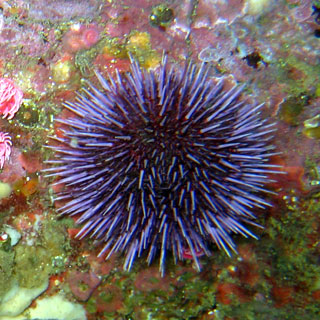The purple sea urchin, who's scientific name is Strongylocentrotus purpuratus is known in Hawaii as wana. It is a spiny, hard-shelled animal that lives on the rocky seafloor, from shallow waters to great depths. It is found off the west coast of North America, in the Pacific Ocean, from Canada to the Baja peninsula. It lives from the intertidal zone in depths of about 33 feet (10 m).
The sea urchin moves very slowly along the sea floor. The anatomy of a purple sea urchin averages about 3 1/4 inches (8.5 cm) across; the spines are about 1/3 inch (1 cm) long. This marine urchin ranges from a light purple to a deep reddish-purple color (the young are green). Adult sea urchins have five-sided radial symmetry. Their skin is hard, and contains chalky plates. Sea urchins have a round body and long spines that portrude from its shell like body. The spines are used for protection, for moving, and for trapping drifting algae.
Their diet includes plant and animal matter which includes algae, sponges, mussels, barnicles, and dead fish.
The sea urchins reproduction cycle consists of female sea urchins releasing several million tiny jelly coated eggs at a time. As they develop the tiny larva swim in the sea and are a part of zooplankton, taking several months to develop into sea urchins. The time from fertilization to reproductive adult is 2-5 years.
An interesting fact on the purple sea urchin is that it is nocternal and does most of its grazing at night. It also has a mouth with five teeth underneath its body to help with grazing. It can not tollerate warm waters.
